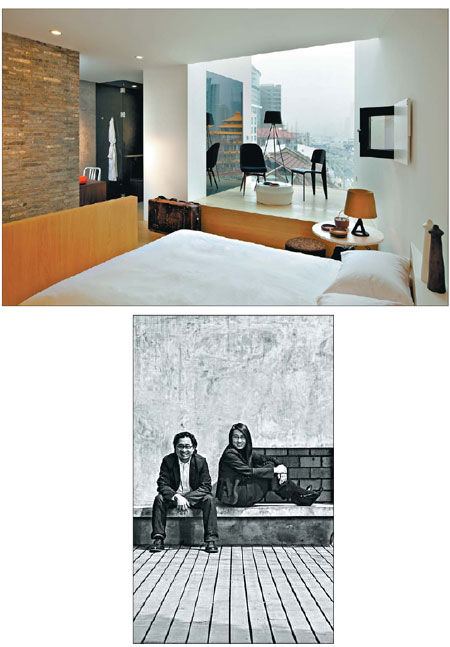Coming home in style
 |
|
Top: The Waterhouse shows off Neri & Hu's unique approach to style and space. Above: Neri and Hu, perfect partners. Neri & Hu Design and Research Office / for China Daily |
Chinese-American architects Lyndon Neri and Rossana Hu found that Shanghai was the perfect place to start a design practice, a furniture company and raise three children. Rebecca Lo talks to them.
When architect Lyndon Neri moved to Shanghai from the US in 2003, he thought it was just about another job. At the time, he was a director at Michael Graves & Associates and was in charge of overseeing Three on the Bund's construction. His wife, architect Rossana Hu, had given birth to their third child only weeks before, and was still on maternity leave.
"I had to make sure that Three on the Bund was done correctly, but relocating was a dilemma," recalls Neri, settling into a sofa at the Waldorf Astoria Shanghai on the Bund. The couple was going to join their family later for afternoon tea in Salon de Ville, both casually dressed in designer black for the Sunday outing.
"We didn't think it was a big deal since it was only supposed to be six weeks," adds Hu. Six weeks stretched into three months. Then SARS hit, and nobody wanted them back. After a year, they were used to Shanghai's lifestyle and began to see the opportunities that the city offered.
"Through working on custom furniture for Three on the Bund, we saw the things we could do with manufacturing facilities so close by," says Hu. "It was amazing, coming from the States, to be so hands on in creating, manufacturing and playing with materials we were unfamiliar with."
"At the same time, it was frustrating because we couldn't get any imported furniture," says Neri. "We saw a lot of copies. Being Chinese and hearing people say that Chinese only copy - well, it was true, but we saw an opportunity to change that perception."
Design Republic was established as a place where both designers and discerning customers could find the latest in contemporary home and lifestyle products from around the world. Neri and Hu also design products under their label Neri & Hu, a collection of furniture, lighting and accessories carried through Design Republic and select retail outlets in key international locales.
Plus, they still practice architecture, through Neri & Hu Design and Research Office. Their projects have included The Waterhouse at South Bund in Shanghai, restaurants for The Opposite House in Beijing and Jason Atherton's restaurant in London. They have a fondness for letting materials speak for themselves, often leaving wood, metal and glass unfinished for a somewhat industrial chic look.
"We are not interested in what is normally considered a classically based beautiful space," says Neri. "We are not afraid to break expectations."
"We don't really see the final aesthetic output as the arrival of the project," says Hu. "We are more interested in issues and experimentation. And through developing issues, we are creating things that take form and shape."
The couple's long hours and frequent travel schedule means that their two sons, age 12 and 8, and daughter, age 10, are often exposed to the world of design. "They come with us on a lot of our business travels, at the expense of their schooling sometimes," shrugs Neri.
"For kids, they have very good taste," says Hu proudly. "They are naturally educated in buildings and art." Despite very busy days, they try to have dinner at home with the family as often as possible. Often afterwards, the classically trained pianist Hu accompanies her children during music lessons.
"Before we go to sleep, we pray together as a family," says Neri.
"That helps us to balance," says Hu.
Neri and Hu have never regretted their decision to make China their home, and strongly believe that the country is ripe for a design revolution.
"China has progressed to the point where it a more mature market," says Hu.
"Shanghai is an international city just like New York City was at the turn of the 19th century," says Neri. "It is a major player, not just financially, but also with design. For us, it is easy to play both cards. But we cannot rely on just being Chinese. We have to play the card that we are the best designers coming up with the best solutions. It's about what China can give on a global stage."
















